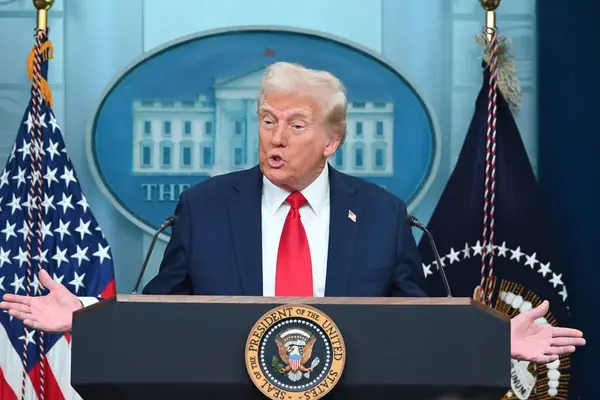Trump Group Purchases $2.5 Billion in Bitcoin, Creating a New Media + Crypto Model.
Author: SuperEx
Translation: Baihua Blockchain

Trump's iconic "policy flip style" seems to be playing out once again—this time within his own business group. Just a day prior, Trump Media & Technology Group (TMTG) denied any such transaction. However, on May 27, it officially confirmed a $2.5 billion Bitcoin purchase plan. Typical Trump style?
This bombshell news not only shocked the market but also pushed Trump to the forefront of a new "crypto-political experiment," sparking a global discussion about the boundaries of power and crypto assets.
What does it mean for a media company to acquire such a massive amount of Bitcoin? Let's analyze this complex operation.
Where does the funding come from? Where is it directed?
First, let's look at the basic question: where does the funding come from?
According to the official announcement, the $2.5 billion is divided into two parts:
$1.5 billion: Raised through the issuance of common stock
$1 billion: Raised through zero-interest convertible preferred notes, priced at a 35% premium
In other words, this is a rather complex financing structure. The common stock portion is direct equity financing; the convertible notes are designed to attract high-risk investors, with potentially high returns if the stock price (and Bitcoin) rises.
If Bitcoin rises → TMTG's balance sheet strengthens → stock price increases → note holders profit upon conversion
If Bitcoin falls → company assets shrink → equity holders (and possibly the company itself) may suffer losses
Thus, this is not just a Bitcoin investment—it attempts to construct a feedback loop fueled by Bitcoin, similar to early MicroStrategy… but this time, it’s not a tech company, but a media content group.
Why hoard Bitcoin?
TMTG CEO Devin Nunes explained, "We see Bitcoin as a tool against financial censorship."
This is a significant statement. But the logic behind it is simple: they want financial self-defense.
Traditionally, companies have to rely on banks, rating agencies, and mainstream financial institutions—often facing restrictions or discrimination. By incorporating Bitcoin as part of their reserve assets, they can detach their asset base from this system, increasing autonomy—but it also brings volatility.
TMTG's initiative echoes recent changes in corporate reserve strategies:
Companies like Semler Scientific and MetaPlanet have purchased Bitcoin as "hard assets"
Even the Czech National Bank plans to include Bitcoin in its reserves
Therefore, TMTG is simply riding this emerging wave: viewing digital assets as the next generation of cash reserve strategies.
How does this feedback loop work?
Now to the critical question: TMTG is neither a mining company nor a crypto trading platform. How does it "monetize" its Bitcoin exposure?
This involves traffic and audience.
TMTG has launched several crypto-native products, such as $TRUMP and $MELANIA meme coins, which have garnered significant attention. Although most holders are at a loss, the market cap has risen, indicating that monetizing IP through tokens is effective.
They have also invested in crypto ETFs, decentralized finance platform TruthFi, and partnered with Crypto.com and Anchorage Digital for custody. They are building a closed-loop system around content + crypto + financial tools. The trust that holds 53% of the company’s shares places this feedback loop under a centralized control system.
In short: TMTG bets that brand + capital + crypto products can form a self-sustaining flywheel.
External Perspective: Trust, Risk, and Centralization Concerns
But all of this is not without risks.
Trust Issues:
TMTG first denied the transaction, then confirmed it 24 hours later. Naturally, some investors expressed skepticism about its transparency. Following the announcement, the company's stock price fell over 12%—clearly, not everyone is on board.
Volatility Exposure:
Bitcoin is currently fluctuating between $108,000 and $110,000. Leverage players like James Wynn being liquidated means TMTG's holding of billions in Bitcoin could face significant balance sheet volatility.
Systemic Centralization Risk:
Some analysts are concerned—if more companies and countries hoard Bitcoin, a new form of "centralized, unregulated" financial risk may emerge.
One prediction suggests that by 2045, institutions could hold 50% of the total Bitcoin supply. This level of concentration raises serious systemic risk signals.
We are witnessing a media content company transform into a digital asset vault. TMTG not only holds Bitcoin but is also issuing tokens, investing capital into decentralized finance, and building a complete framework parallel to the traditional financial system. This "vault" serves as:
Value storage
Valuation anchor
Confidence engine
It could yield astronomical returns—or, if things go south, trigger severe adjustments.
Regardless, this is one of the boldest experiments we have seen: a media company evolving into a crypto asset management company. Its success hinges on two factors:
The long-term performance of Bitcoin
Whether the market accepts this model
Final Thoughts
If MicroStrategy is the "tech company test" for corporate Bitcoin allocation,
TMTG is the "IP + finance integration test."
Whether successful or not, it raises a question worth pondering: Can content companies leverage crypto assets to upgrade, transform—even become decentralized finance giants?
We may soon find out the answer.
Article link: https://www.hellobtc.com/kp/du/05/5870.html
Source: https://s.c1ns.cn/DEdQB
免责声明:本文章仅代表作者个人观点,不代表本平台的立场和观点。本文章仅供信息分享,不构成对任何人的任何投资建议。用户与作者之间的任何争议,与本平台无关。如网页中刊载的文章或图片涉及侵权,请提供相关的权利证明和身份证明发送邮件到support@aicoin.com,本平台相关工作人员将会进行核查。




